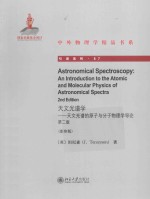
1.Why Record Spectra of Astronomical Objects? 1
1.1 A Historical Introduction 1
1.2 What One Can Learn from Studying Spectra 3
2.TheNature of Spectra 7
2.1 Transitions 7
2.2 Absorption and Emission 8
2.3 Other Measures of Transition Probabilities 10
2.4 Stimulated Emission 10
2.5 Optical Depth 11
2.6 Critical Density 12
2.7 Wavelength or Frequency? 13
2.8 The Electromagnetic Spectrum 14
3.Atomic Hydrogen 17
3.1 Overview 17
3.2 The Schr?dinger Equation of Hydrogen-Like Atoms 17
3.3 Reduced Mass 18
3.4 Atomic Units 19
3.5 Wavefunctions for Hydrogen 20
3.6 Energy Levels and Quantum Numbers 21
3.7 H-Atom Discrete Spectra 23
3.8 H-Atom Spectra in Different Locations 29
3.8.1 Balmer series 29
3.8.2 Lyman series 33
3.8.3 Infrared lines 35
3.9 H-Atom Continuum Spectra 35
3.9.1 Processes 35
3.9.2 H-atom emission in HⅡ regions 36
3.10 Radio Recombination Lines 38
3.11 Radio Recombination Lines for Other Atoms 40
3.12 Angular Momentum Coupling in the Hydrogen Atom 43
3.13 The Fine Structure of Hydrogen 44
3.14 Hyperfine Structure in the H Atom 45
3.15 Allowed Transitions 46
3.16 Hydrogen in Nebulae 47
4.Complex Atoms 51
4.1 General Considerations 51
4.2 Central Field Model 52
4.3 Indistinguishable Particles 54
4.4 Electron Configurations 55
4.5 The Periodic Table 56
4.6 Ions 58
4.7 Angular Momentum in Complex Atoms 59
4.7.1 L-S or Russell-Saunders coupling 59
4.7.2 j-j coupling 61
4.7.3 Why two coupling schemes? 61
4.8 Spectroscopic Notation 62
4.9 Parity of the Wavefunction 63
4.10 Terms and Levels in Complex Atoms 64
5.Helium Spectra 69
5.1 He I and He II Spectra 69
5.2 Selection Rules for Complex Atoms 71
5.3 Observing Forbidden Lines 74
5.4 Grotrian Diagrams 75
5.5 Potential Felt by Electrons in Complex Atoms 77
5.6 Emissions of Helium-Like Ions 78
6.Alkali Atoms 81
6.1 Sodium 81
6.2 Spin-Orbit Interactions 84
6.3 Fine Structure Transitions 88
6.4 Astronomical Sodium Spectra 89
6.5 Other Alkali Metal-Like Spectra 93
7.Spectra of Nebulae 99
7.1 Nebuliun 100
7.2 The Bowen Mechanism 104
7.3 Two Valence Electrons 107
7.4 Autoionisation and Recombination 109
8.Spectra in Magnetic Fields 115
8.1 Uniform Magnetic Field 116
8.2 Strong Magnetic Field 117
8.3 Weak Magnetic Field 118
8.3.1 The normal Zeeman effect 118
8.3.2 The anomolous Zeeman effect 119
8.4 Spectra in Magnetic Field 120
9.X-Ray Spectra 123
9.1 Inner Shell Processes 123
9.2 The Solar Corona 127
9.3 The Structure of Highly Ionised Atoms 127
9.4 Isotope Effects 131
10.Molecular Structure 135
10.1 The Born-Oppenheimer Approximation 136
10.2 Electronic Structure of Diatomics 137
10.2.1 Labelling of electronic states 140
10.2.2 Symmetry 141
10.2.3 State labels 143
10.3 Schr?dinger Equation 144
10.3.1 Nuclear motion in diatomic molecules 144
10.4 Fractionation 149
10.5 Vibration-Rotation Energy Levels 150
10.6 Temperature Effects 152
10.6.1 Rotational state populations 152
10.6.2 Vibrational state populations 154
10.6.3 Electronic state populations 155
11.Rotational Spectra 157
11.1 Rotational Structure of Polyatomic Molecules 157
11.2 SelectionRules:Pure Rotational Transitions 160
11.3 Selection Rules 161
11.4 Isotope Effects 166
11.5 Rotational Spectra of Other Molecules 166
11.6 Rotational Spectra of Molecular Hydrogen 170
11.7 Maser Emissions 170
12.Vlibration-Rotation Spectra 175
12.1 Vlibrations in Polyatomic Molecules 175
12.2 Vibrational Transitions 177
12.2.1 Structure of the spectrum 178
12.2.2 Isotope effects 181
12.2.3 Hydrogen molecule vibrational spectra 181
12.3 Astronomical Spectra 183
13.Electronic Spectra of Diatomic Molecules 187
13.1 Electronic Transitions 187
13.2 Selection Rules 188
13.2.1 Vibrational selection rules 189
13.2.2 Rotational selection rules 190
13.3 Transition Frequencies 192
13.4 Astronomical Spectra 193
13.5 Non-1∑ Electronic States 195
Solutions to Model Problems 199
Further Reading and Bibliography 215
Index 217
- 《新编高中物理竞赛教程习题全解》钟小平主编;钟小平,倪国富,曹海奇编写 2019
- 《数学物理方法与仿真 第3版》杨华军 2020
- 《中学物理奥赛辅导:热学 光学 近代物理学》崔宏滨 2012
- 《长江口物理、化学与生态环境调查图集》于非 2019
- 《大学物理简明教程 下 第2版》施卫主编 2020
- 《慢性呼吸系统疾病物理治疗工作手册》(荷)瑞克·考斯林克(RikGosselink) 2020
- 《医学物理学》洪洋 2020
- 《黄瓜低霜霉威残留性生理生化及分子基础研究》吴鹏,郭茜茜,朱琨编著 2018
- 《初中物理知识地图》赵端旭 2017
- 《写给孩子的趣味天文学》(俄)雅科夫·伊西达洛维奇·别莱利曼著 2019
